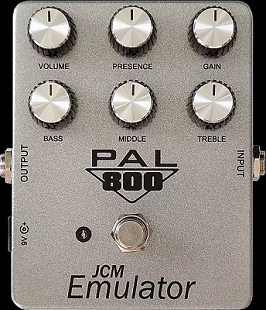JCM Emulator
PedalPalFX PAL-800 JCM Emulator - a "JCM-800 in-a-box" Distortion pedal. We're sort of of the opinion that we don't quite understand how this pedal exists. You've probably heard of the dire condition of the current state of Venezuela (at least as of this writing). No one outside of the government seems able to get any food to eat. It's hard to conceive that PedalPalFX could be building such a great pedal when the country is missing - you know - FOOD.
- Thermionic Studios has one(1) JCM Emulator available for rental.
Serial number 8001708-121
Controls

- Knob 1 - "Volume": Adjusts the output level of the pedal. Fully clockwise is loudest.
- Knob 2 - "Presence": Adjusts the "high highs" ("presence" or "sparkle"). Negative feedback control for additional highs.
- Knob 3 - "Gain": Selects the amount of signal to be clipped by the "preamp" in the pedal.
- Knob 4 - "Bass": Bass tone control. Clockwise is more.
- Knob 5 - "Middle": Adjusts the middle tone frequencies. Fully clockwise is max mids.
- Knob 6 - "Treble": Tone control for treble frequencies with fully clockwise being maximum.
- Footswitch 1 - "On/Off": This footswitch toggles the pedal between engaged/active ("On"), and bypassed ("Off")
Other PedalPalFX are actually named "JCM-800" and "Plexi" and so on. This is actually named differently: "JCM Emulator". and the design basis of this pedal isn't quite a typical Marshall JCM 800. It's actually an emulated version of the "JCM-800" Silver Jubilee. The Silver Jubilee, or 2555/2550 was made for, and made famous by Slash of Guns and Roses. Just like a Silver Jubilee, the controls on this pedal are highly interactive. Consider the tone controls: like its forebearer, the JCM 800, the tone controls are essentially passive volume controls, contoured so that each frequency knob is just a volume control for its corresponding frequency band. In other words, becoming fully comfortable with this pedal may require a little time in order to get used to.
Turning all the tone controls to ten is actually just like a JCM 800. It simply lets all the signal come through without any kind of volume attenuation.
Bypass: Evidence suggests Buffered
We can see 6 transistors inside this pedal, which actually suggests it's a buffered bypass. But we don't have a schematic and haven't yet (and given time constraints may never) traced the PCB and its components in order to draw up a corresponding schematic. That said, PedalPalFX insists the pedal is a copy of its equivalent, just using solid-state components as opposed to vacuum tubes.
If one takes into consideration that of the three vacuum tubes in a JCM-800, then it also has to be pointed out that two of those tubes are actually used for amplification and distortion. The third tube is used for what's called a "PI" or phase inverter. The phase inverter creates two signals: it keeps the original signal, and generates a second signal which is an inversion of the sine wave of the electrical signal. This is done so both the original, and the phase-shifted signals can be pushed into alternate sides of the output transformer, resulting in better operating parameters, and much more output at the speakers. This is what is described as a "push-pull" amplifier and, is much more efficient than a single signal going one direction into an output transformer.
This means that all "heavy" vintage Marshall amps use at least two tubes for amplification (we cab quibble about channels later). Since each tube has two amplification stages in it, and since 2 (gain stages) X 2 (tubes) = 4, this should be the equivalent of 4 transistors.
In terms of understanding whether this pedal is buffered or true-bypass, given the description above, our first conclusion is that this is a buffered bypass pedal with buffers both on the signal coming in and the signal going out. That's the only way, as of this moment, we can understand a 6-transistor "JCM-800-architected" pedal that should need only have 4 transistors.
General Information
According to the PedalPalFX site, this pedal is now Out of Production, meaning that as of the writing of this article, they will not be making any more. Only 363 were ever made.
Sales Channel
PedalPalFX has an interesting business model. They sell all their pedals direct-to-the-consumer through the Reverb.com website. While we happened to have gotten ours second-hand from a posting to the Facebook Marketplace, it's only because we had been aware of this pedal for a while and had been wanting one. Given the extremely low build numbers for this pedal, we were fortunate in that moment.
Build Quality
We opened up this pedal in order to get the serial number and were astonished at the quality of the craftsmanship of this pedal. It's really quite beautiful to behold. We took a gutshot of it and still don't think the picture renders justice to the workmanship inside this pedal.
Pedal Manual
Having scoured the PedalPalFX website and the interwebs for a manual, we have found none. Having bought the pedal second-hand, we're unaware of any manual that came with the pedal itself - the previous owner didn't indicate that the pedal came with one. Given the evidence, it's probable, especially given the renown of the JCM 800, that a manual was seen as unnecessary or superfluous. This article is likely as close as one will get to a user's or owner's manual.
Phase Inversion: Yes/No
| Schematic ID | Electronic Part | Action | Phase State |
|---|---|---|---|
| X | X | X | X |
Schematic
There is no schematic that we're aware of that's been issued by PedalPalFX for this pedal. We believe we've found a similar work-alike and after some review may be posting it shortly.
Artists
We are currently unaware of any artists actively using the pedal now, or who have in the past.
- Additional Sources